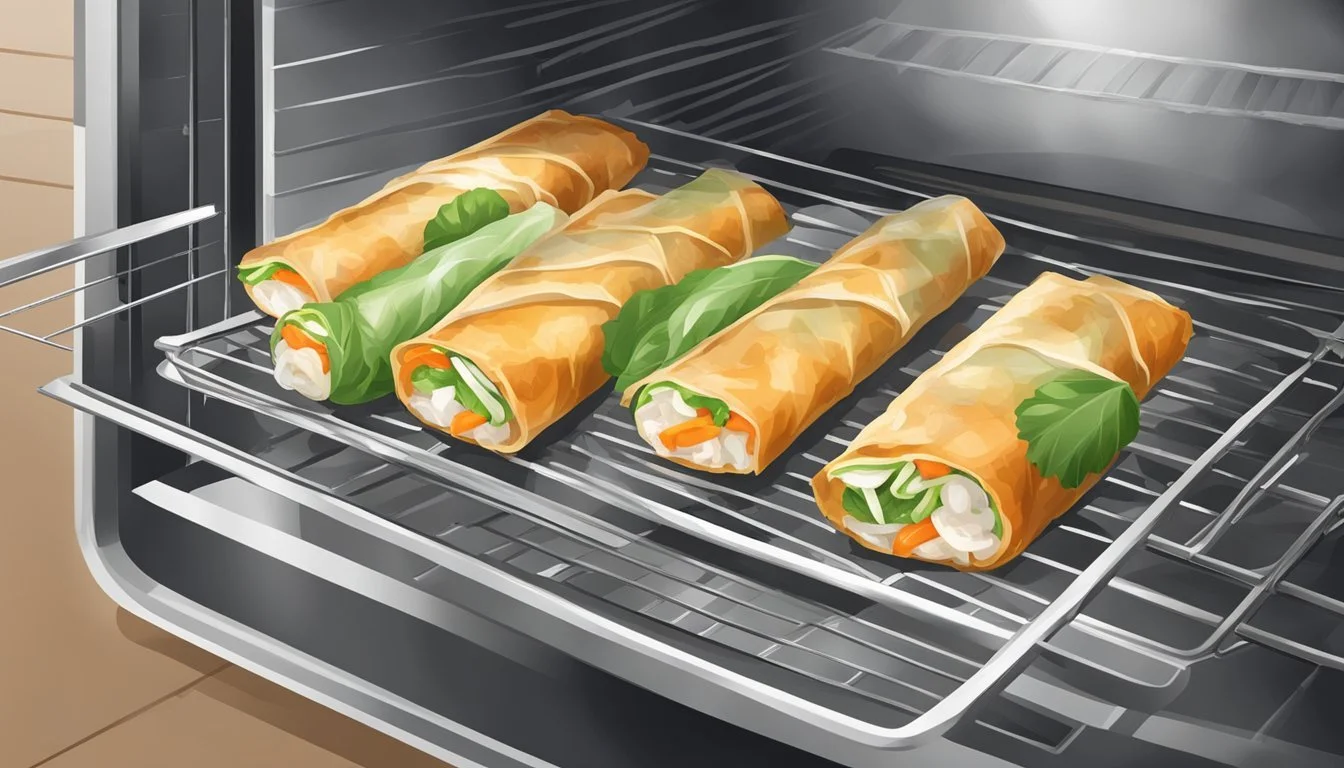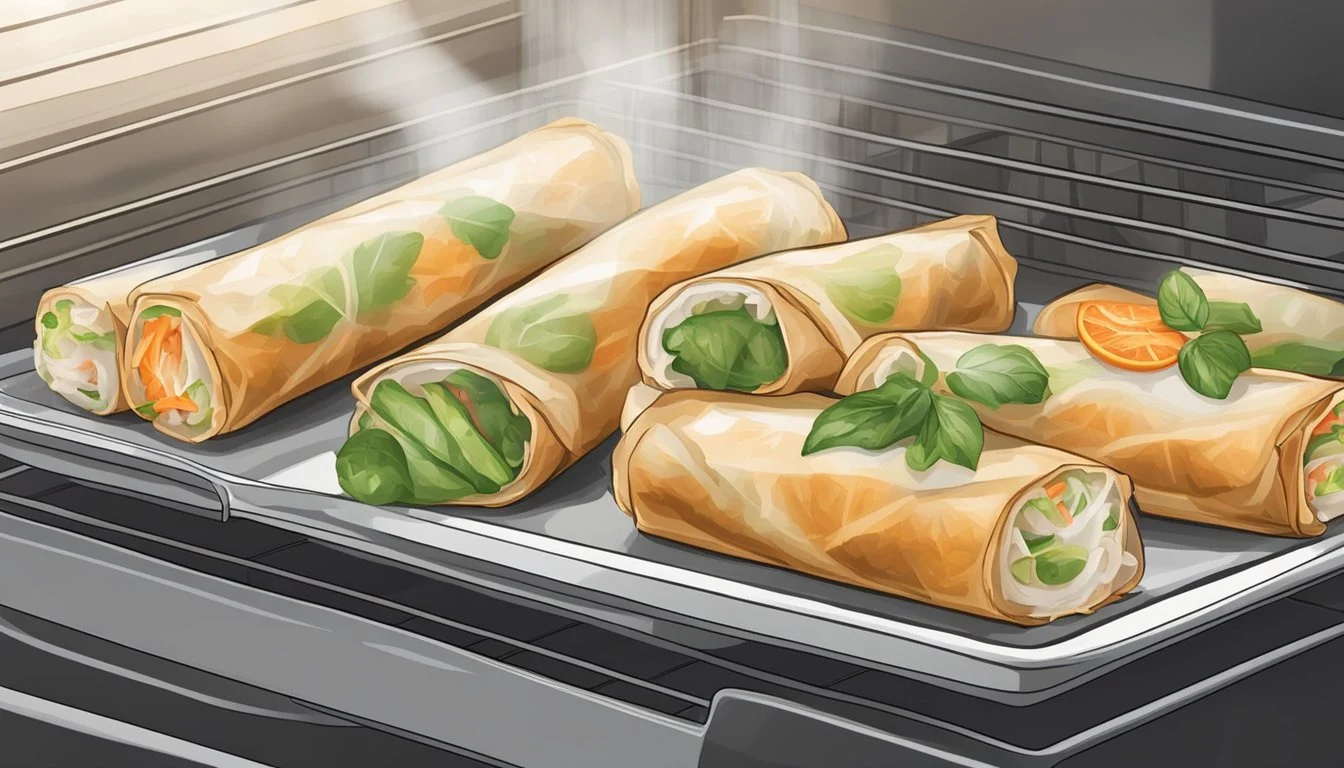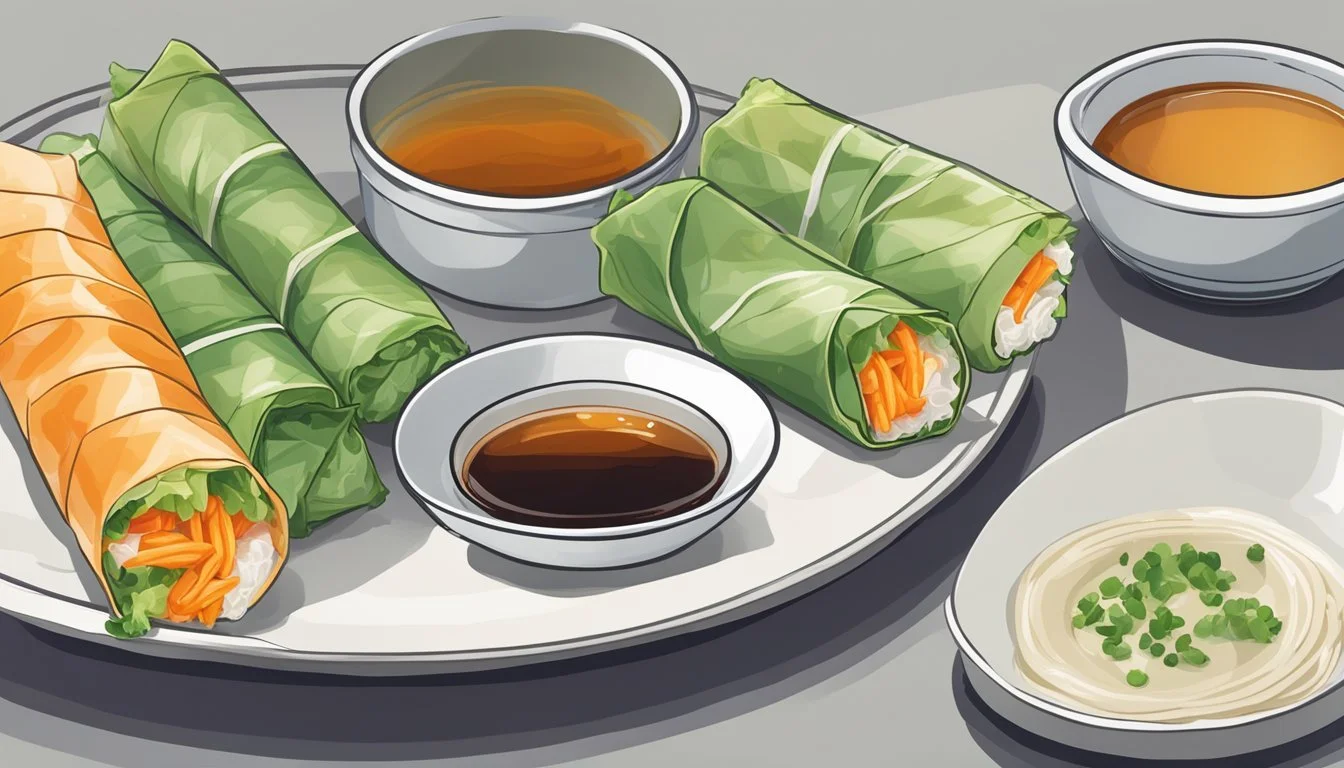Best Way to Reheat a Vietnamese Spring Roll
Tips for Maintaining Its Crunchiness
Vietnamese spring rolls, known for their delightful crunch and flavor-packed fillings, are a culinary favorite. However, maintaining their crisp texture upon reheating is a common challenge. Preserving the delicate balance between the crispy exterior and the fresh ingredients inside is key to enjoying leftover spring rolls as if they were freshly made.
Several methods exist to reheat spring rolls, but not all will yield the desired crispiness. Oven baking, air frying, and careful deep-frying are among the techniques that can revive the texture of the spring rolls’ wrappers without compromising the quality of their filling. Each approach has its merits, and selecting the right one depends on the available kitchen appliances and personal preferences for convenience and taste.
Understanding the nuances of each reheating method allows individuals to bring back the desirable snap to the spring rolls' exterior. This ensures that the reheated spring rolls offer a sensory experience akin to their initial serving, combining a satisfying texture with the flavors that make Vietnamese cuisine universally admired.
Overview of Reheating Vietnamese Spring Rolls
Reheating Vietnamese spring rolls is an art in maintaining the right texture and flavor. These popular appetizers or snacks originally have a crispy exterior with a moist, flavorful filling. When reheating leftover spring rolls, the objective is to restore the crispy texture without drying out the ingredients inside or letting them become soggy from excess moisture. There are several methods one can employ, each with its own steps and considerations.
Effective Methods
Oven Reheating
Preheat oven to 350°F (175°C).
Arrange the spring rolls on a baking sheet.
Heat for ten minutes, then flip for even crispness.
Microwave then Oven
Start with 30 seconds in the microwave.
Transfer to 350°F (175°C) preheated oven for a few minutes.
Stovetop Frying
Heat oil in a pot to 350°F (175°C).
Fry spring rolls for 30-45 seconds until golden brown.
Rest on paper towels to absorb extra oil.
Each method aims to revive the rolls' texture without compromising their taste. The oven method is ideal for ensuring even heating and achieving a crispy texture. However, for quick reheating, the microwave-then-oven technique can yield good results, as the microwave step reintroduces interior moisture before crisping up in the oven. For those who prefer the traditional crispy bite, stovetop frying recreates the original cooking process, resulting in a near-fresh quality with the right level of crunchiness. It's important to let the rolls come to room temperature for a short period before any reheating method to ensure even warmth throughout.
Preparation for Reheating
Before reheating Vietnamese spring rolls, proper preparation is crucial to preserve their crispness and ensure food safety. If the spring rolls have been stored in the fridge, they should be allowed to sit at room temperature for approximately 10 minutes. This step ensures an even distribution of heat during the reheating process.
For those who have opted to store their spring rolls in the freezer, it’s recommended to transfer them to the refrigerator first, allowing them to thaw slowly. This gradual process helps maintain the spring rolls’ texture. When freezing, placing spring rolls in an airtight container or wrapping them securely in plastic wrap is essential to prevent freezer burn and retain quality.
Whether the spring rolls were refrigerated or frozen, one must always check that they are wrapped in a paper towel when reheating. The paper towel absorbs excess moisture, thereby aiding in keeping the rolls crisp. When arranging spring rolls for reheating, it is best to place them in a single layer to ensure uniform heat exposure.
Remember, the key to successful reheating lies in the preliminary steps taken to store spring rolls correctly, be it in the fridge or freezer. An airtight container is critical when refrigerating to prevent other odors from seeping into the delicate spring rolls. Respecting these initial preparations guarantees the spring rolls’ flavor and texture are as close to their original state as possible upon reheating.
Reheating Methods Overview
Reheating Vietnamese spring rolls correctly is crucial to preserve their crispy texture and tender interior. Several methods can be employed, each offering a unique benefit depending on the desired outcome and resources available.
Oven Method
Using an oven or toaster oven allows for even heating that contributes to a golden brown texture. To utilize this method:
Preheat the oven to 350°F (175°C).
Line a baking sheet with parchment paper for easy cleanup.
Place spring rolls in a single layer on the sheet and heat until crisp, typically about 10 minutes.
Air Fryer Technique
An air fryer promotes a crispy texture without excessive oil. For this technique:
Set the air fryer to 350-375°F (180°C).
Place spring rolls in the air fryer basket; space them out for proper airflow.
Heat for 3-5 minutes, shaking the basket halfway through for even heating.
Skillet Method
For those seeking a crispy outer shell with a moist inside, a skillet on the stovetop works well. Follow these steps:
Heat a small amount of oil in a non-stick pan.
Once hot, add the spring rolls and cook for a few minutes on each side until they achieve a golden hue.
Microwave Tips
The microwave offers quick heating but can sometimes make spring rolls soggy. To counteract this:
Place spring rolls on a microwave-safe plate.
Cover with a damp paper towel to maintain moisture.
Heat in short intervals, checking frequently for warmth.
Deep Frying for Freshness
Deep frying spring rolls in hot oil can restore their original texture. To do this:
Heat oil, like canola oil, to a high temperature, typically around 350°F (180°C).
Fry the spring rolls until they are golden brown, ensuring the internal temperature is hot.
Steaming to Retain Moisture
Steaming is a gentler method that works especially well for spring rolls filled with vegetables, meat, or seafood. For the steaming method:
Fill a steamer with water and bring it to a simmer.
Place spring rolls inside without overcrowding and steam until heated through, preserving the filling's moisture.
Arranging the Spring Rolls for Reheating
When reheating Vietnamese spring rolls, the goal is to ensure even heating while maintaining the rolls' crispness. The arrangement of the spring rolls is a critical step in the reheating process. Here's how to properly arrange them:
Space Between Each Roll: Place the spring rolls on the baking sheet or wire rack with enough space between them to allow air to circulate. This spacing prevents steam from accumulating and ensures an even reheat.
Use of Parchment Paper or Aluminum Foil: If using a baking sheet, line it with parchment paper or aluminum foil to avoid sticking and to make for easier cleanup.
Optimal Placement on Baking Sheet:
On Wire Rack: Ideally, use a wire rack on top of the baking sheet to elevate the spring rolls. This promotes airflow around the entire surface of each roll, contributing to even crisping.
Without Wire Rack: If a wire rack is unavailable, place the spring rolls directly on the lined baking sheet, but remember to rotate them halfway through the reheating process for uniform heat distribution.
Using these techniques will facilitate even heating and help retain the spring rolls’ desired crispy texture. It is worth noting that overcrowding the rolls can result in subpar reheating, so they should be arranged in a single layer without touching each other.
Ensuring the Ideal Internal Temperature
When reheating Vietnamese spring rolls, reaching the right internal temperature is critical for both food safety and to maintain the delicious qualities of the roll. An internal temperature of 165°F (74°C) is often recommended for dishes containing meat or shrimp to ensure they are safe to consume.
An oven can be used to achieve this ideal internal temperature. Preheat the oven to approximately 350°F (177°C) before placing the spring rolls on a baking sheet. A food thermometer should be used to determine when they've reached the ideal internal temperature. It's important to insert the thermometer into the center of the spring roll without touching the sides to get an accurate reading.
Cooking Tool Temperature Duration Oven 350°F (177°C) Until internal temperature reaches 165°F (74°C) Air Fryer 350-375°F (177-190°C) Check after 3-5 minutes
Remember:
Consistently check the spring rolls to prevent overheating, which can lead to drying out the fillings.
If heating multiple spring rolls, ensure they're not touching so heat can circulate and warm them evenly.
For spring rolls with meat or shrimp fillings, using a thermometer to check the internal temperature is the best practice to ensure they are fully reheated.
Proper technique leaves the Vietnamese spring rolls crispy on the outside with a fully reheated, safe-to-eat interior.
Side Dishes and Condiments
When serving Vietnamese spring rolls, pairing them with the right side dishes and condiments not only enhances the flavors but also respects the traditional way of enjoying this dish. Accompaniments should be chosen to complement the delicate taste and crispy texture of the reheated spring rolls.
Dipping Sauces
Dipping sauces are a staple alongside Vietnamese spring rolls. The most common include:
Hoisin Sauce: A rich, sweet, and slightly salty sauce that marries well with the herbs commonly found in spring rolls.
Peanut Sauce: Thick and creamy with a balance of sweet, savory, and spicy notes, often topped with crushed peanuts for added texture.
Sweet and Sour Sauce: Typically featuring tamarind or lime juice, it provides a bright and zesty contrast to the savory rolls.
Chili Sauce: Perfect for those who prefer a kick of heat. It can be served on its own or mixed with other sauces to amplify their flavor profiles.
Soy Sauce is less common but can be offered as a simple and salty dipping option, sometimes seasoned with a touch of lime juice or slices of chili for extra complexity.
Sauce Type Description Common Additions Hoisin Sweet, thick, and rich. Crushed garlic and/or sesame seeds Peanut Creamy with a balance of sweet, savory, and spicy. Extra crushed peanuts on top Sweet and Sour Bright and tangy, often with a base of tamarind or lime. Finely sliced carrots for sweetness Chili Spicy and bold, often clear and slightly sweetened. Garlic or Vietnamese coriander Soy Sauce Salty and umami-rich, less commonly used. Lime juice or chili slices (optional)
While dipping sauces are paramount, offering a variety of side dishes such as pickled vegetables (What wine goes well with pickled vegetables?) or light salads can provide a palate-cleansing contrast to the fried spring rolls. This balance of flavors and textures ensures that each bite of the Vietnamese spring roll remains a delightful experience.
Storing Leftover and Frozen Spring Rolls
Proper storage techniques are crucial for maintaining the quality and crispiness of leftover and frozen Vietnamese spring rolls. Whether refrigerating for short-term freshness or freezing for prolonged periods, the right methods can keep them tasting as close to freshly made as possible.
Refrigeration Advice
For the short-term storage of leftover spring rolls, one should place them in an airtight container to retain their crispiness while avoiding moisture build-up that could make them soggy. They should be kept in a single layer to prevent sticking and can be refrigerated like this for up to 24 hours without significant loss of texture.
Freezing Techniques for Freshness
When freezing spring rolls, flash freezing is a highly effective technique:
Arrange the spring rolls on a tray with space between them.
Place the tray in the freezer for a few hours until the spring rolls are fully frozen.
Transfer the frozen spring rolls to a freezer-safe airtight container or a resealable plastic bag, squeezing out excess air.
This method prevents the spring rolls from sticking together and helps maintain their crispy texture upon reheating. When stored properly, they can remain in the freezer for up to a month.
Safety Measures for Deep Frying at Home
When deep frying Vietnamese spring rolls at home, maintaining safety is paramount to prevent accidents involving hot oil. She should always be vigilant and prepared, as the kitchen transforms into a high-heat environment. Adhering to safety measures not only ensures the crispness of the spring rolls but also personal wellbeing.
Before starting, one must ensure that the stovetop is clean and clear of flammable materials. An individual should always use a deep pot to limit oil splatter and should avoid filling it more than halfway with oil to prevent overflow once the spring rolls are added.
Here are key safety tips to follow:
Prevent Oil Spillage: She should carefully place spring rolls into the oil using long-handled kitchen tongs to maintain a safe distance from the hot oil.
Avoid Water Contact: Any water coming into contact with hot oil can cause splattering; thus, the spring rolls need to be dry before frying.
Regulate Temperature: It's crucial to consistently monitor the oil temperature, ensuring it is around 350°F, as overly hot oil can ignite.
Additionally, she should equip herself with the right protective gear:
Protective Clothing: Wearing an apron shields her clothes and skin from oil splashes.
Use of Mitts: Heat-resistant mitts should be worn when handling the pot or other hot utensils to prevent burns.
In case of an oil fire, she should never use water to extinguish it; instead, they can safely smother it using a metal lid and turn off the heat. Keeping a fire extinguisher within reach in the kitchen is always recommended. These steps are designed to promote confidence in her safety while achieving that perfect crispy spring roll.
Additional Tips for Crispiness
When reheating Vietnamese spring rolls, achieving that perfect crispiness is often sought after. Here are some pointers to ensure they regain their appealing texture:
Oven Reheating: Preheat the oven to 350°F (180°C). They recommend using a wire rack to allow heat circulation. Place the spring rolls on the rack and heat them for about 10-12 minutes. If a wire rack isn't available, a baking tray can suffice, with the spring rolls being turned halfway through to ensure even crispiness.
Paper Towel Method: Post-heating, one should drain the spring rolls on a paper towel. This step is crucial to remove excess oil which might make the spring rolls soggy.
Low Heat Approach: If using an oven, consider setting it to a lower temperature and extending the reheating time. This method helps avoid burning while still drying the outer layer enough to become crispy.
Anticipate Carryover Cooking: After removing spring rolls from the oven, they will continue cooking slightly from residual heat. It's best to remove them just before they reach the desired level of crispiness.
By following these simple steps, one can reheat spring rolls properly and enjoy a crunchy, satisfying bite. Remember, attention to detail in these additional tips will elevate the overall quality of reheated Vietnamese spring rolls.
Common Mistakes to Avoid
When reheating Vietnamese spring rolls, several mistakes can lead to less than satisfactory results. To preserve the crispness of the spring roll, one should be aware of these common errors:
Sogginess from Moisture: It's crucial to avoid moisture buildup. Wrapping spring rolls in plastic wrap or covering them with a damp paper towel while microwaving will trap steam and result in soggy skin. Instead, they should lay on a dry surface.
Overcrowding the Pan: When using a pan or air fryer, adding too many spring rolls at once can limit the air circulation, causing uneven reheating and a soggy texture. The spring rolls require space between them to allow the skin to crisp up evenly.
Applying High Heat Too Quickly: High heat may seem like the quickest way to reheat but doing so can burn the outer layer before the inside is warmed. A moderate temperature allows the spring roll to heat through without charring.
Inappropriately Using a Microwave: Although quick, microwaving is a common mistake. It excels in heating food fast but at the expense of texture, often leaving the wrapper rubbery or the interior overheated, while the wrapper remains cool.
Here is a brief breakdown of each method:
Method Attention Point Oil frying Watch for oil temperature and duration Microwave Avoid if crispness is priority Oven/Air Fryer Ensure not to overcrowd and flip carefully
By avoiding these errors, one can better maintain the quality and texture of reheated Vietnamese spring rolls.
Troubleshooting Common Issues
When reheating Vietnamese spring rolls, maintaining the delicate balance between a crispy exterior and a moist inside is key. Here are solutions to common problems encountered during the reheating process:
Soggy Spring Rolls: The culprit is often excessive moisture. To avoid sogginess, one should not cover spring rolls with plastic wrap or a moist paper towel during reheating. Using an oven or air fryer instead of a microwave can help maintain crispness.
Lack of Crispness: If the spring rolls aren't crisping up, the temperature may need adjusting. In an oven or air fryer, ensure a temperature range of 350-375°F (180-190°C). This high heat helps to crisp the exterior quickly without drying out the interior.
Uneven Cooking: Spring rolls might heat unevenly, leaving some parts colder. To prevent this, they should rest at room temperature for about ten minutes before reheating. Also, turn or flip them once midway through cooking time to ensure even heat distribution.
Overcooking: Constant vigilance is vital. Overcooking can result in tough and overly crispy textures. Monitor the spring rolls closely and adjust the cooking time as needed—usually between 3-5 minutes.
Quick Reference Table:
Issue Solution Soggy Spring Rolls Avoid covering during reheating, use oven or air fryer. Lack of Crispness Adjust temperature to 350-375°F (180-190°C). Uneven Cooking Let sit at room temp, flip once during reheating. Overcooking Watch closely, typically reheat for 3-5 minutes.
By addressing these common issues with the outlined solutions, one can enjoy crispy, evenly heated spring rolls that retain their original texture and flavor.







